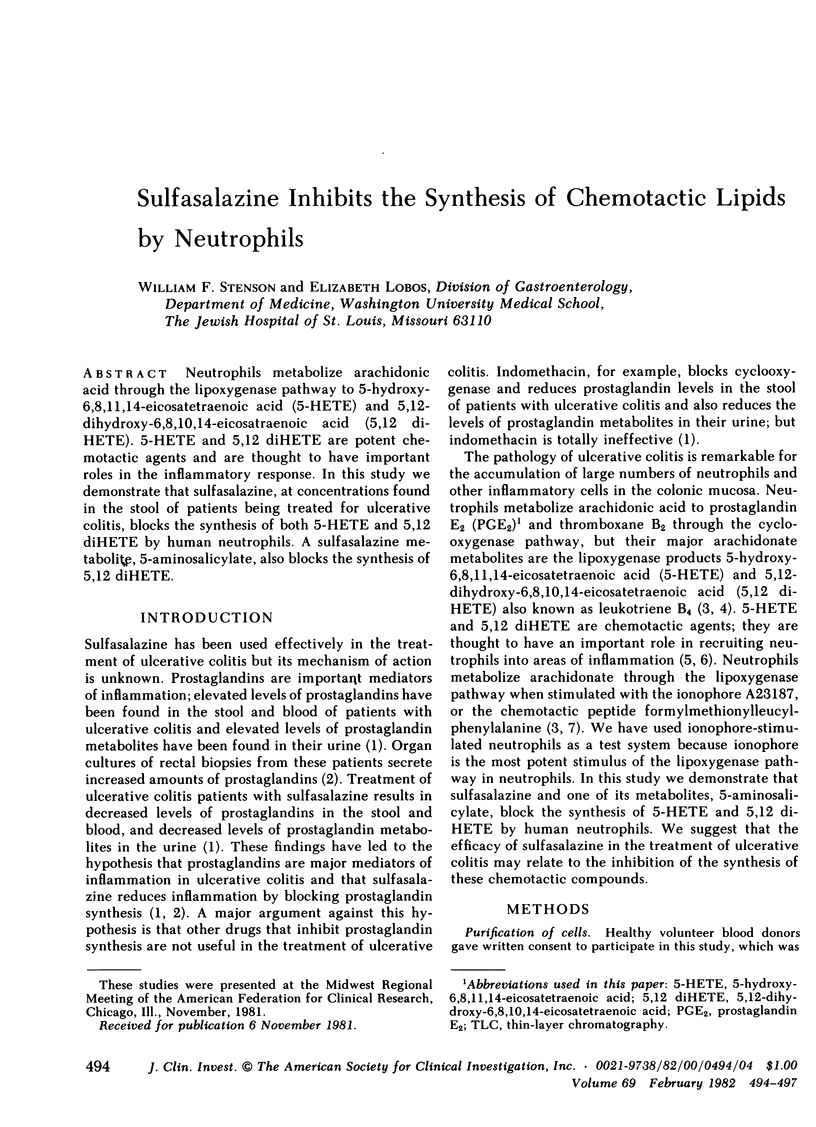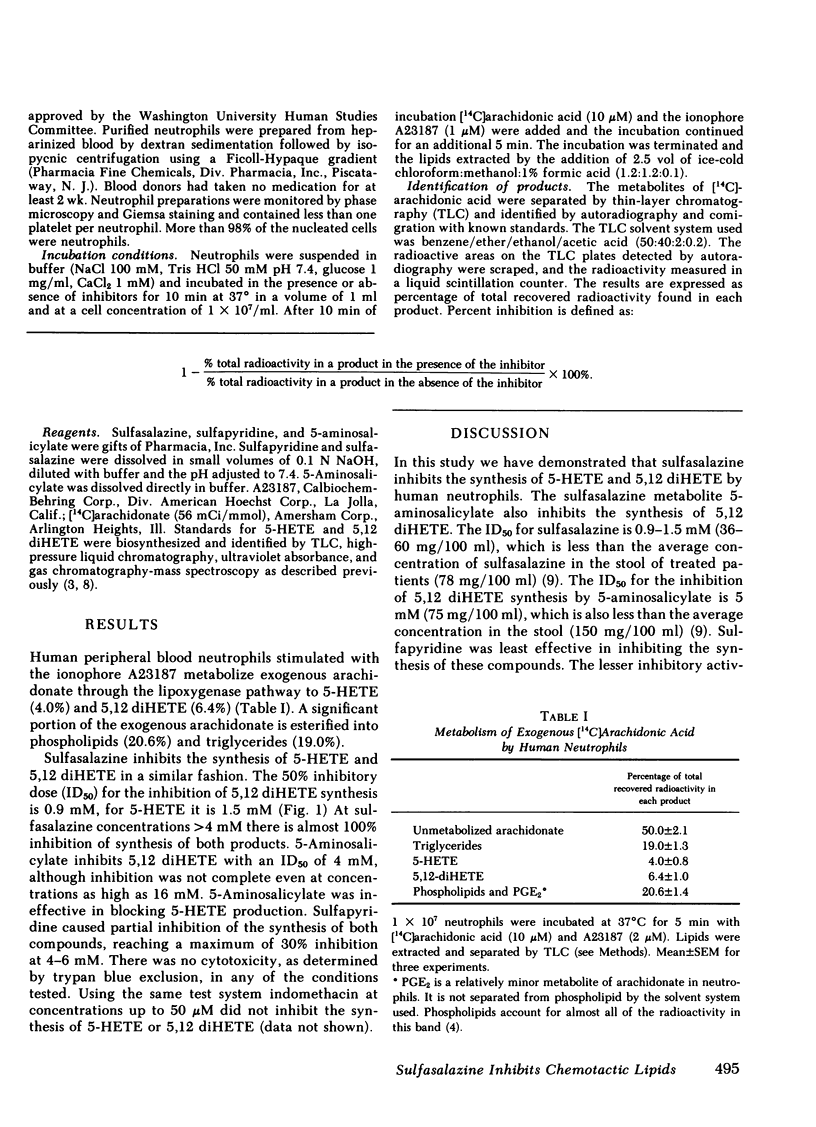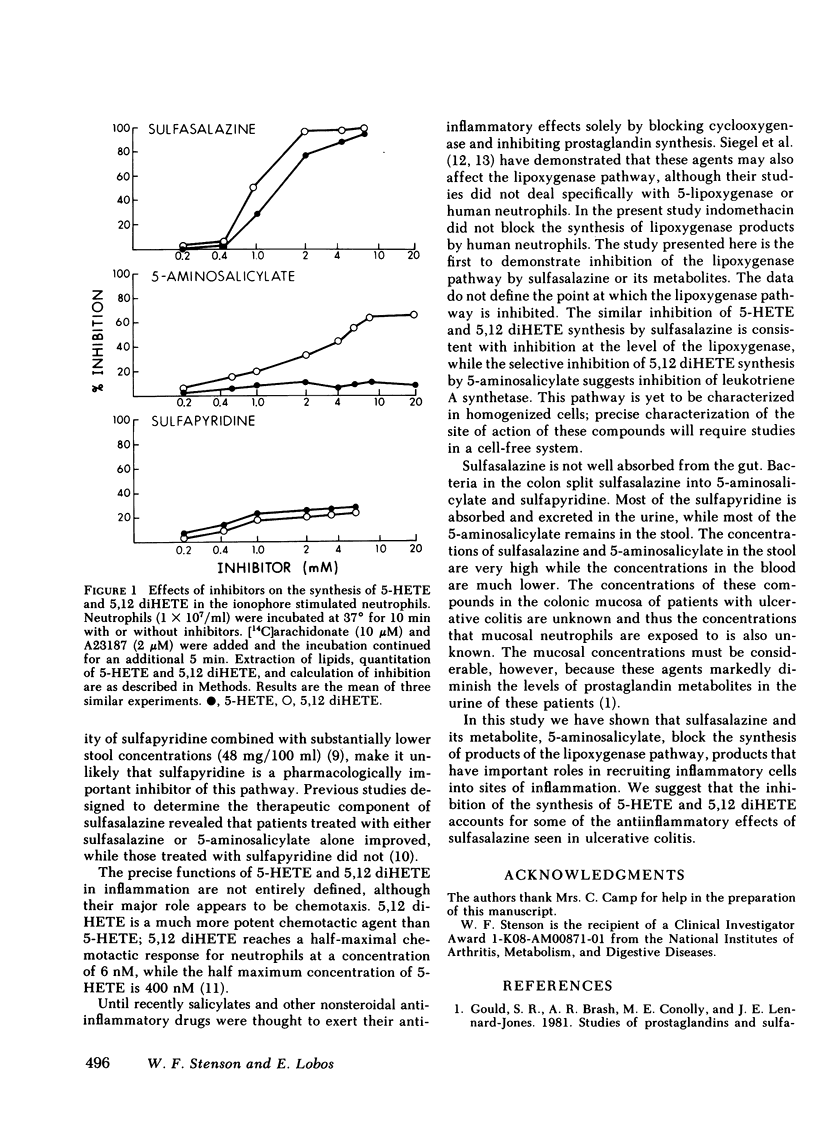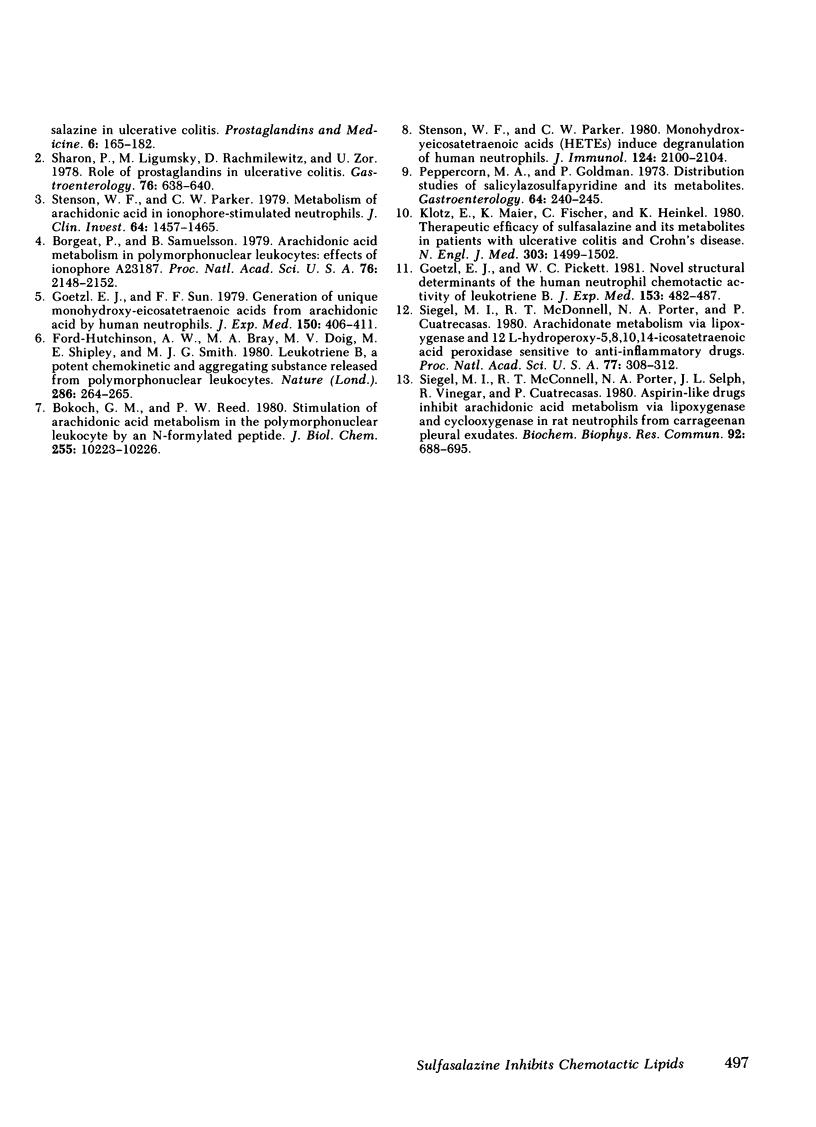Abstract
Neutrophils metabolize arachidonic acid through the liposygenase pathway to 5-hydroxy-6,8,11,14-eicosatetrenoic acid (5-HETE) and 5,12-dihydroxy-6,8,10,14-eicosatraenoic acid (5,12 diHETE). 5-HETE and 5,12diHETE are potent chemotactic agents and are thought to have important roles in the inflammatory response. In this study we demonstrate the sulfasalazine, at concentrations found in the stool of patients being treated for ulcerative colitis, blocks the synthesis of both 5-HETE and 5,12 diHETE by human neutrophils. A sulfasalazine metabolite, 5-aminosalicylate, also blocks the synthesis of 5,12 diHETE.
Full text
PDF



Selected References
These references are in PubMed. This may not be the complete list of references from this article.
- Bokoch G. M., Reed P. W. Stimulation of arachidonic acid metabolism in the polymorphonuclear leukocyte by an N-formylated peptide. Comparison with ionophore A23187. J Biol Chem. 1980 Nov 10;255(21):10223–10226. [PubMed] [Google Scholar]
- Borgeat P., Samuelsson B. Arachidonic acid metabolism in polymorphonuclear leukocytes: effects of ionophore A23187. Proc Natl Acad Sci U S A. 1979 May;76(5):2148–2152. doi: 10.1073/pnas.76.5.2148. [DOI] [PMC free article] [PubMed] [Google Scholar]
- Ford-Hutchinson A. W., Bray M. A., Doig M. V., Shipley M. E., Smith M. J. Leukotriene B, a potent chemokinetic and aggregating substance released from polymorphonuclear leukocytes. Nature. 1980 Jul 17;286(5770):264–265. doi: 10.1038/286264a0. [DOI] [PubMed] [Google Scholar]
- Goetzl E. J., Pickett W. C. Novel structural determinants of the human neutrophil chemotactic activity of leukotriene B. J Exp Med. 1981 Feb 1;153(2):482–487. doi: 10.1084/jem.153.2.482. [DOI] [PMC free article] [PubMed] [Google Scholar]
- Goetzl E. J., Sun F. F. Generation of unique mono-hydroxy-eicosatetraenoic acids from arachidonic acid by human neutrophils. J Exp Med. 1979 Aug 1;150(2):406–411. doi: 10.1084/jem.150.2.406. [DOI] [PMC free article] [PubMed] [Google Scholar]
- Gould S. R., Brash A. R., Conolly M. E., Lennard-Jones J. E. Studies of prostaglandins and sulphasalazine in ulcerative colitis. Prostaglandins Med. 1981 Feb;6(2):165–182. doi: 10.1016/0161-4630(81)90088-4. [DOI] [PubMed] [Google Scholar]
- Klotz U., Maier K., Fischer C., Heinkel K. Therapeutic efficacy of sulfasalazine and its metabolites in patients with ulcerative colitis and Crohn's disease. N Engl J Med. 1980 Dec 25;303(26):1499–1502. doi: 10.1056/NEJM198012253032602. [DOI] [PubMed] [Google Scholar]
- Peppercorn M. A., Goldman P. Distribution studies of salicylazosulfapyridine and its metabolites. Gastroenterology. 1973 Feb;64(2):240–245. [PubMed] [Google Scholar]
- Sharon P., Ligumsky M., Rachmilewitz D., Zor U. Role of prostaglandins in ulcerative colitis. Enhanced production during active disease and inhibition by sulfasalazine. Gastroenterology. 1978 Oct;75(4):638–640. [PubMed] [Google Scholar]
- Siegel M. I., McConnell R. T., Porter N. A., Cuatrecasas P. Arachidonate metabolism via lipoxygenase and 12L-hydroperoxy-5,8,10,14-icosatetraenoic acid peroxidase sensitive to anti-inflammatory drugs. Proc Natl Acad Sci U S A. 1980 Jan;77(1):308–312. doi: 10.1073/pnas.77.1.308. [DOI] [PMC free article] [PubMed] [Google Scholar]
- Siegel M. I., McConnell R. T., Porter N. A., Selph J. L., Truax J. F., Vinegar R., Cuatrecasas P. Aspirin-like drugs inhibit arachidonic acid metabolism via lipoxygenase and cyclo-oxygenase in rat neutrophils from carrageenan pleural exudates. Biochem Biophys Res Commun. 1980 Jan 29;92(2):688–695. doi: 10.1016/0006-291x(80)90388-5. [DOI] [PubMed] [Google Scholar]
- Stenson W. F., Parker C. W. Metabolism of arachidonic acid in ionophore-stimulated neutrophils. Esterification of a hydroxylated metabolite into phospholipids. J Clin Invest. 1979 Nov;64(5):1457–1465. doi: 10.1172/JCI109604. [DOI] [PMC free article] [PubMed] [Google Scholar]
- Stenson W. F., Parker C. W. Monohydroxyeicosatetraenoic acids (HETEs) induce degranulation of human neutrophils. J Immunol. 1980 May;124(5):2100–2104. [PubMed] [Google Scholar]


